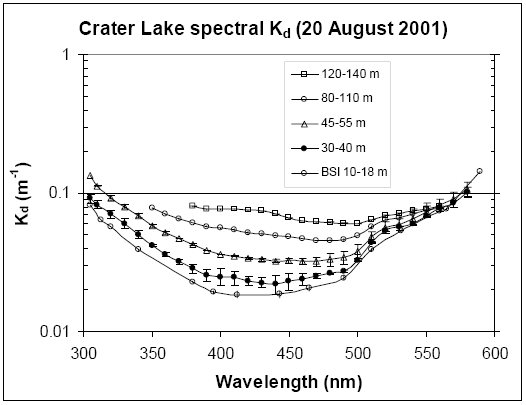Ultraviolet Radiation and Bio-optics in Crater Lake, Oregon, 2005
RESULTS
Possible UVR Impacts on the Crater Lake Ecosystem
Optical absorption by phytoplankton contributes directly to diffuse attenuation and absorption spectra can also reveal a protective response of phytoplankton to UVR exposure. Figure 12A shows spectral absorption measurements for five depths made 20 August 2001 on GF/F glass fiber filters. Distinct chlorophyll-a peaks are visible at 430 and 675 nm. Chlorophyll-a concentrations calculated from 675 nm peaks (0.038–0.38 mg m-3 using ap*675=0.040) closely match the [Chl-a] calculated from data in Fig 3 using the diffuse attenuation model of Morel and Maritorena 2001. Typical ap*675 = 0.035 according to Sathyendranath et al. (1987).
The arrow in Figure 12A indicates a peak at 325 nm that appears clearly at depths of 25 and 50 m. This wavelength is consistent with UV-B protective compounds called micosporine-like amino acids or MAAs (Tartarotti et al., 2001) known to be produced by certain phytoplankton when exposed to UV-B radiation. Figure 12B shows depth trends for UV-B irradiance (Ed, 320), particulate absorption ratios (ap330:ap675 and ap440:ap675), and the Fchl:cp660 ratio (from the 20 August 2001 curve in Figure 11B). The ratio ap330:ap675 follows a similar declining trend with depth as observed in Kd,320:Kd,380 ratios (Figure 6), suggesting that phytoplankton produce more MAAs relative to photosynthetic pigments when exposed to strong sunlight containing UV-B.
One possible response to strong UVR in an aquatic ecosystem is inhibition of growth and survival for members of the plankton community. The low concentration of chlorophyll observed near the surface (Figures 10A, 11, 12A) and scarcity of other organisms (Larson et al., 1996b) are consistent with this impact but other factors such as nutrient limitation could also be a dominant factor. A natural experiment with solar UV-B radiation has taken place over the past 20 years because of daily, seasonal, and interannual variations in stratospheric ozone above Crater Lake. Figure 13A shows the record of stratospheric ozone (averaged for several weeks before the typical mid-month sampling dates for phytoplankton). Also plotted are the chlorophyll-a concentrations from Figure 10A. The large variations in phytoplankton apparent in Figure 13A may be partly explained by atmospheric variations in ozone that lead to inverse variations in UV-B radiation reaching the lake surface. Figure 13B shows the positive regression relationship between chlorophyll-a and stratospheric ozone (Chl-a, 40–140 m: y = 0.025x – 7.4, r2 = 0.49; Chl-a, 0–40 m: y = 0.004x – 1.07, r2 = 0.27) consistent with UV-B irradiance accounting for 27–49% of the variation in phytoplankton pigment concentration either directly, or by inhibiting predators that feed on phytoplankton grazers.
Figure 3. Crater Lake spectral diffuse attenuation from spectral irradiance in Figure 1, plus an average for 10–18 m depth calculated from profiles by PRR-800 and PUV-2500 instruments from Biospherical Instruments, Inc. (BSI). LI-1800uw Kd was calculated for each depth interval and then averaged for a range of depths (error bars are +/-S.E. of mean for depth ranges included in mean). BSI Kd was calculated for 10–18 m from polynomial regressions of Ed,Z vs depth to reduce noise from surface reflections. Note that the minimum Kd was at 412 nm. Values for wavelengths longer than 560 nm are excluded below 40 m because of Raman scatter artifact described in Figure 2B. Shorter UV wavelengths are excluded at depths below 55 m because of instrument detection limits. The lowest Kd,320 value was 0.057 m-1 (PUV-2500, 10–18m).


